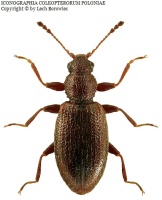Підтримуємо Вільну Україну
 We Support Free Ukraine
We Support Free Ukraine

Biodiversity Map
Taxa

Taxon count: 13
-
Corticaria pubescens Set as tree root ↑
Show taxon data → ⚑ [62] → Show taxon data
[62] → Show taxon data -
Corticaria brouni Set as tree root ↑
Show taxon data → → Show taxon data -
Corticaria capensis Set as tree root ↑
Show taxon data → → Show taxon data -
Corticaria concinnula Set as tree root ↑
Show taxon data → → Show taxon data -
Corticaria diluta Set as tree root ↑
Show taxon data → → Show taxon data -
Corticaria grossa Set as tree root ↑
Show taxon data → → Show taxon data -
Corticaria intricata Set as tree root ↑
Show taxon data → → Show taxon data -
Corticaria piligera Set as tree root ↑
Show taxon data → → Show taxon data -
Corticaria robusta Set as tree root ↑
Show taxon data → → Show taxon data -
Corticaria testacea Set as tree root ↑
Show taxon data → → Show taxon data -
Corticaria tincta Set as tree root ↑
Show taxon data → → Show taxon data -
Latridius longicornis Set as tree root ↑
Show taxon data → → Show taxon data -
Latridius pubescens Set as tree root ↑
Show taxon data → → Show taxon data
-
Arthropodaphylum
Click to switch
to select orders
and filters > -
Hexapodasubphylum
Click to switch
to select orders
and filters > -
Insectaclass
Click to switch
to select orders
and filters > -
Coleopteraorder
Click to set
as the main taxon
and as a base
← of the left panel > -
Polyphagasuborder
Click to set
as the main taxon
and as a base
← of the left panel > -
Cucujiformiaseries
Click to set
as the main taxon
and as a base
← of the left panel > -
Cucujoideasuperfamily
Click to set
as the main taxon
and as a base
← of the left panel > -
Latridiidaefamily
Click to set
as the main taxon
and as a base
← of the left panel > -
Corticariinaesubfamily
Click to set
as the main taxon
and as a base
← of the left panel > -
Corticariagenus
Click to set
as the main taxon
and as a base
← of the left panel >
species:
Corticaria pubescens
PL
YES
name status: valid name
BioMap ID: 1020337
taxon code: 3673
taxonomy checked: YES
Data on distribution in Poland

Statistics
- Records: 62
- Publications: 2
- Collections: 3
- Publication authors: 4
- Illustrations (iconography): 1
- Photos (specimen/observation): lacking
Taxon description
[KFP 3673: Corticaria tincta] Gatunek palearktyczny, rozpowszechniony w całej Europie, w Fennoskandii sięgający po skrajne prowincje północne, wykazywany też z Madery, Wysp Kanaryjskich, południowej Afryki, Ameryki i Australii. W Polsce występuje od Bałtyku aż po Tatry, ale był notowany z nielicznych miejscowości. Występuje zarówno w biotopach naturalnych, jak i w środowiskach synantropijnych. Znajdowany na śluzowcach i grzybach żagwiowatych rozwijających się na drewnie pni i pniaków, pod odstającą korą, na leżących gałęziach oraz na wiązkach chrustu; spotykany również w przegrzybiałej próchnicy i opadłym listowiu. W stodołach, szopach, spichlerzach, magazynach, pryzmach kompostowych przebywa wśród pleśniejących szczątków i produktów roślinnych.
Illustrations
... browse
 Corticaria
Corticariapubescens
External data sources
- Ostatnie rekordy
-
1056925
 ⊡
⊡ Latridiidae: Corticaria pubescens, PL, Nizina Wielkopolsko-Kujawska, Orle, UTM CD41, 1990, leg. J. Siekierski
Latridiidae: Corticaria pubescens, PL, Nizina Wielkopolsko-Kujawska, Orle, UTM CD41, 1990, leg. J. Siekierski -
1056924
 ⊡
⊡ Latridiidae: Corticaria pubescens, PL, Nizina Wielkopolsko-Kujawska, Orle, UTM CD41, 1990, leg. J. Siekierski
Latridiidae: Corticaria pubescens, PL, Nizina Wielkopolsko-Kujawska, Orle, UTM CD41, 1990, leg. J. Siekierski -
1056923
 ⊡
⊡ Latridiidae: Corticaria pubescens, PL, Nizina Wielkopolsko-Kujawska, Orle, UTM CD41, 1990, leg. J. Siekierski
Latridiidae: Corticaria pubescens, PL, Nizina Wielkopolsko-Kujawska, Orle, UTM CD41, 1990, leg. J. Siekierski -
774269
 ⊡
⊡ Latridiidae: Corticaria pubescens, PL, Dolny Śląsk, Wrocław, Mokry Dwór, UTM XS45, 1994, leg. L. Borowiec, coll. Uniw. Wrocławski, ZBiTE
Latridiidae: Corticaria pubescens, PL, Dolny Śląsk, Wrocław, Mokry Dwór, UTM XS45, 1994, leg. L. Borowiec, coll. Uniw. Wrocławski, ZBiTE -
774268
 ⊡
⊡ Latridiidae: Corticaria pubescens, PL, Dolny Śląsk, rez. Zimna Woda, UTM WS78, 1992, leg. L. Borowiec, coll. Uniw. Wrocławski, ZBiTE
Latridiidae: Corticaria pubescens, PL, Dolny Śląsk, rez. Zimna Woda, UTM WS78, 1992, leg. L. Borowiec, coll. Uniw. Wrocławski, ZBiTE -
774267
 ⊡
⊡ Latridiidae: Corticaria pubescens, PL, Dolny Śląsk, Wrocław, Wojnów, UTM XS56, 1992, leg. J. Kania, coll. Uniw. Wrocławski, ZBiTE
Latridiidae: Corticaria pubescens, PL, Dolny Śląsk, Wrocław, Wojnów, UTM XS56, 1992, leg. J. Kania, coll. Uniw. Wrocławski, ZBiTE -
774266
 ⊡
⊡ Latridiidae: Corticaria pubescens, PL, Dolny Śląsk, Wrocław, Wojnów, UTM XS56, 1992, leg. L. Borowiec, coll. Uniw. Wrocławski, ZBiTE
Latridiidae: Corticaria pubescens, PL, Dolny Śląsk, Wrocław, Wojnów, UTM XS56, 1992, leg. L. Borowiec, coll. Uniw. Wrocławski, ZBiTE -
774265
 ⊡
⊡ Latridiidae: Corticaria pubescens, PL, Roztocze, Lipowiec ad Zwierzyniec, UTM FB30, 1989, leg. L. Borowiec, coll. Uniw. Wrocławski, ZBiTE
Latridiidae: Corticaria pubescens, PL, Roztocze, Lipowiec ad Zwierzyniec, UTM FB30, 1989, leg. L. Borowiec, coll. Uniw. Wrocławski, ZBiTE -
774264
 ⊡
⊡ Latridiidae: Corticaria pubescens, PL, Nizina Wielkopolsko-Kujawska, Wielkopolska, Ruda Milicka, UTM XT61, 1989, leg. L. Borowiec, coll. Uniw. Wrocławski, ZBiTE
Latridiidae: Corticaria pubescens, PL, Nizina Wielkopolsko-Kujawska, Wielkopolska, Ruda Milicka, UTM XT61, 1989, leg. L. Borowiec, coll. Uniw. Wrocławski, ZBiTE -
737923
 ×
× Latridiidae: Corticaria pubescens, PL (Majewski 1997(1996)b)
Latridiidae: Corticaria pubescens, PL (Majewski 1997(1996)b) - ... more
- Powiązane publikacje
-
Majewski T. [2] 1997(1996)b. Nowe dane o rozmieszczeniu Latridiidae (Coleoptera) w Polsce. Wiad. Entomol., 15(4):227-236.
 full text
full text Show records
Show records -
Burakowski B., Mroczkowski M., Stefańska J. 1986b. Chrząszcze – Coleoptera. Cucujoidea, część 2. Katalog Fauny Polski, XXIII, 13, Warszawa.
 Show records
Show records



